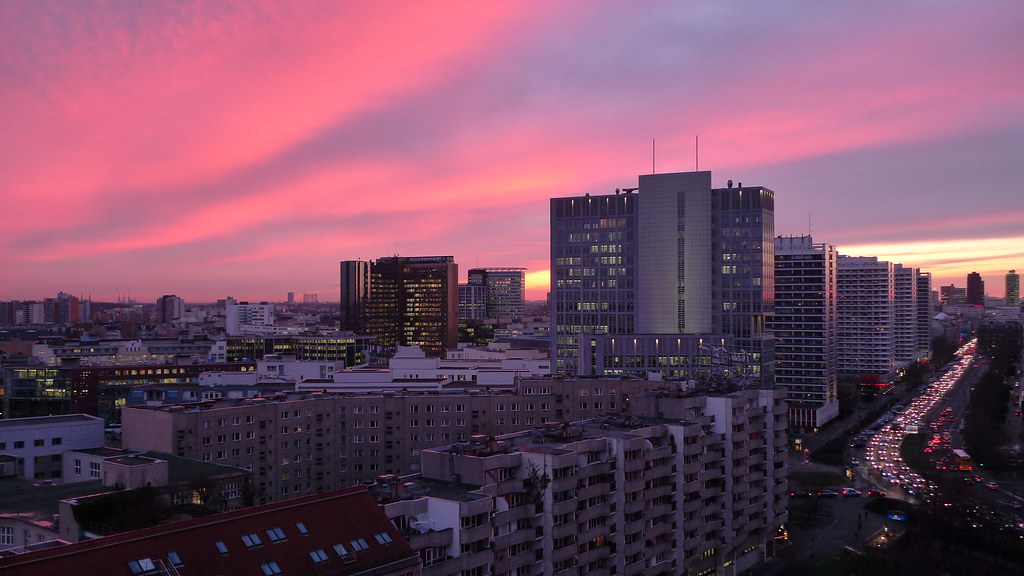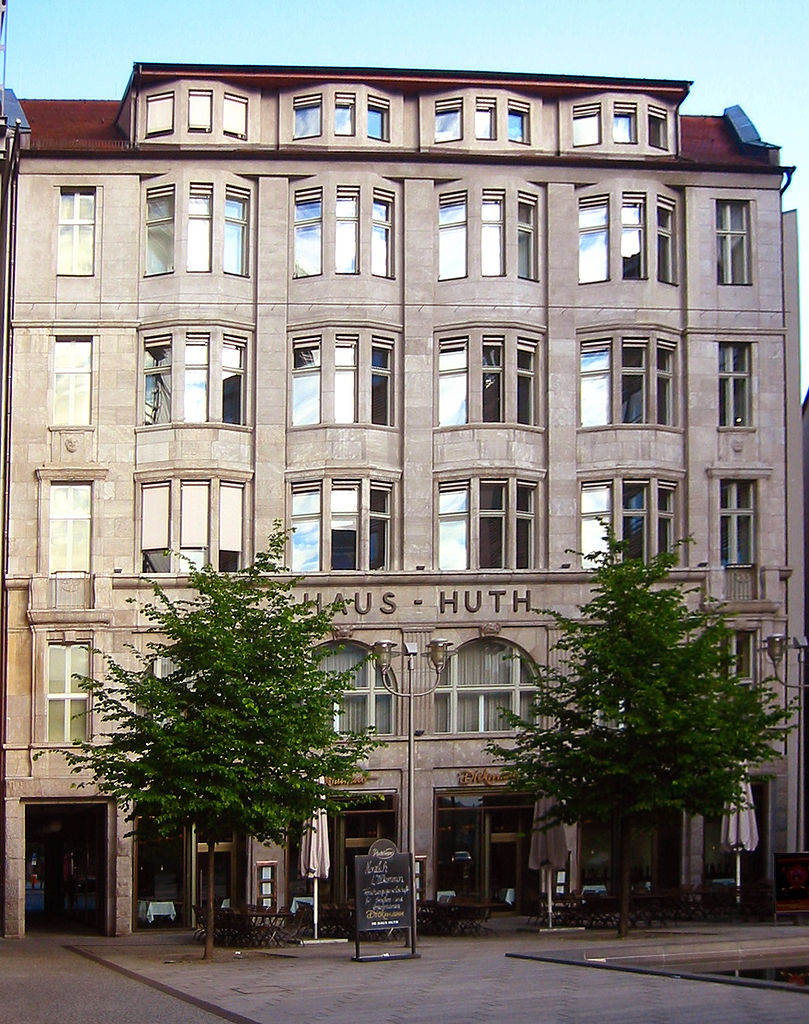
A wild storm is brewing outside my window here on Leipziger Strasse in Berlin. It might be a relief for Berliners after such an unseasonably hot day. Regardless of how much Germans yearn for hot summers, the reality of such temperatures does seem to cause general stress.
This is a great storm for anyone lucky enough to watch it while enjoying a cup of tea from inside a cozy room (as I am). But for those streaming out of their offices on the street below, clutching umbrellas or racing through pelting rain sheltered by briefcases, it’s a bad situation.
I’m glad my Smithsonian tour guests arrive tomorrow. This would not be welcoming weather. For me, though, it’s ideal. For the time being, the weather is keeping me inside, rather than out roaming the city of Berlin.
Why is that ideal? On every tour, my goal is to arrive a day early and find economical lodgings in an off-beat part of town (although Leipziger Strasse is not off-beat). Then I use the extra night to adjust to the time change, review my lectures, and catch up on e-tasks.
Beyond that, I can read! Preparing for this tour I turned to my favorite book that details (and I do mean details) the history of Berlin: Faust’s Metropolis. In a ridiculous last-minute decision, I dumped all 3.9 pounds of it into my suitcase. Amazingly, the suitcase was still a pound under weight, although surely I’ll have to give this copy away before the return flight (think “German marzipan”).
Truth be told, though, my favorite part of arriving early involves food. Immediately after dropping my suitcase, I find the nearest grocery store and indulge in my favorite “German foods.” No, not Sauerkraut and Bratwurst! Rather, yummy, tender butter lettuce (Kopfsalat), plump cherry tomatoes from Brandenburg, savory canned fish from the North Sea, corn “rice”-cakes, (Maiswaffeln), herbed soft cheese (Bresso), local onions, and heavily seeded bread (imagine whole-grained granola pressed into bread shape). This time, I grabbed them all, stuffed them into my heroic travel purse, and reached my room just before the storm exploded.
The storm is getting wilder. A violent clap of thunder worthy of ten 1812 Overtures just boomed out. Cascades of lightning (Blitzen) are turning the leafy trees to silver. It’s so intense now, I wonder if I should continue to sit in the middle of my big, open window. But, oh, it’s marvelous to watch.
Tomorrow the weather should be good. Our group will land in sunshine, then blearily, but happily, board a luxury bus for the Hilton. For this one-week tour of Berlin, I’ll be working with Travel Director Monika Steele Knight, a cultured, unflappable, deeply thoughtful woman who works at the German Reichstag as well. Our group doesn’t yet know what a treat awaits them by having her insights available. My readers might also be interested in her compelling story of traveling through Europe with a severely autistic son, found in an English translation under the title Tomorrow Can Wait.
Monika would have been quite young when the Berlin Wall fell. But like everyone here, no matter what age, that event has shaped her biographical DNA. The fact is, whether one lived on the inside of the Wall, or the outside, the severing of Europe by Communism and the resulting cruel repression of millions of Germans by the despicable Stasi (East German secret police) has not vanished from the collective memory. Nor is it likely to in the near future.
People say it takes decades to get past historical disasters. That’s not correct. It takes centuries. In fact, let’s consider the horrors of the Thirty-Years’ War (1618-1648)—a series of wars still etched in the psyche of northern Europeans.
For me, The Thirty Years’ War was a test question somewhere in ninth-grade World History: “How long was the Thirty-Years’ War?” I’m serious. That’s probably what the questions was. Certainly I had no understanding of a vast percentage of Europe being torn asunder for three decades.
Ostensibly, yes, it was a religious war (at least, that’s what a ninth-grader would be expected to write). In fact, the Thirty Years’ War was a complex struggle kicked off by religious divisions and waged by many parties in order to decimate rival dynasties, expand territory, and gain access to rivers and the sea.

The most famed—horrific—example of destruction during the Thirty Years’ War goes under the name “the Sack of Magdeburg” or, oddly, the “Magdeberg Hochzeit” (Wedding). In late May 1631, nearly all of the inhabitants of Magdeburg were slaughtered within just a few days. Some sources say twenty thousand people. Others say thirty thousand. Trust me, people still remember.
Still, our stay in Berlin will focus mostly on World-War II history and the division of Germany into East and West. If your sense of the latter event needs refreshing, I’d recommend a book called Forty Autumns. Perhaps it goes too far to call it a “page-turner,” but you’ll find yourself fully engaged as author Nina Willner interweaves historical facts with the inevitable personal tragedy brought to families on both sides of the Wall.
Nina’s mother escaped East Germany as a young gal (more than once, but was dragged back). Ultimately she got out, married an American soldier, and ended up raising her family in the US. Nina grew up keenly aware of her missing East German family, particularly the grandparents she would never meet.
Nina ended up as an adult working for Intelligence in West Germany, crossing many times into the Eastern Zone. Her familial exile closed with the fall of the Berlin Wall in November 1989, whereupon she was able to reunite freely with cousins, aunts, and uncles. She describes it all with a sharp eye, rather than a surplus of emotion, just as the title Forty Autumns might suggest.

I seem to be full of book suggestions today, don’t I? Meanwhile, the rain is abating. Lighter skies are edging over the treetops. It wouldn’t surprise me if someone dries off the tables of the sidewalk café below and, two hours from now, people will be sitting outside, enjoying a summer’s evening.
In fact, to get on local time, I’d be well advised to get out of this room and walk over to Potsdamer Platz. If only it were available in English, I’d make one more suggestion for a fascinating book called Das letzte Haus am Potsdamer Platz (The Last House on Potsdamer Square).

Here we find the saga of the sole historic building left standing in a once bustling square brought to desolation during World War II. Lonely, the “Haus Huth” sat throughout 40-years of a divided Germany, the square itself dissected by the barbed wire of the Berlin Wall. Today, the house is alive again, flanked by ultra-modern glass buildings that make up a revived Potsdamer Square.
That’s enough book titles for one post. Next week, I’ll report on how it all went. Since we’ll be immersed in Berlin, chances are, it will go fabulously well.



